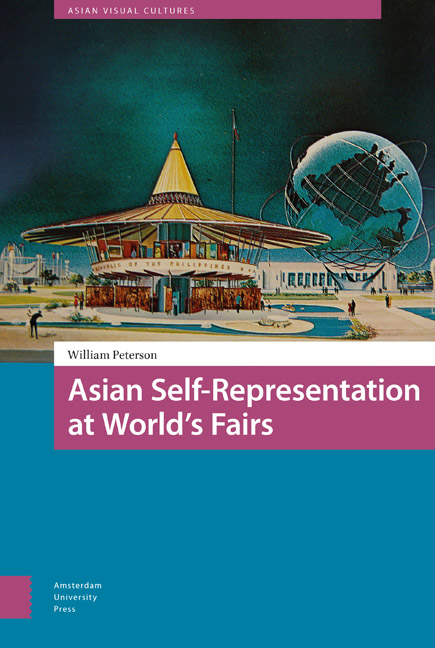Book contents
- Frontmatter
- Dedication
- Contents
- List of Figures
- Acknowledgements
- Note on Works Cited
- Note on Asian Names
- 1 Introduction: Setting the Stage
- 2 The Master of the Form: Japan at San Francisco's 1915 Panama-Pacific International Exposition
- 3 The New China and Chinese-Americanness: China at San Francisco's 1915 Panama-Pacific International Exposition
- 4 Performing Japan in the ‘World of Tomorrow’: Japan at the 1939-1940 New York World's Fair
- 5 From ‘Panda Diplomacy’ to Acrobat Diplomacy: China at the Brisbane's Expo ‘88
- 6 Fashion, Dance, and Representing the Filipina: The Philippines at the 1964-1965 New York World's Fair
- 7 Performing Modernity under Sukarno's ‘Roving Eye’: Indonesia at the 1964-1965 New York World's Fair
- 8 Maximizing Affect, Minimizing Impact with Hansik: South Korea at the 2015 Milan International Exposition
- 9 Hard and Soft Power in the Thai Pavilion: The Spectral Presence of King Bhumibol at the 2015 Milan Exposition
- 10 Conclusion: The Future of Asian Self-Representation at the International Exposition
- Works Cited
- Index
6 - Fashion, Dance, and Representing the Filipina: The Philippines at the 1964-1965 New York World's Fair
Published online by Cambridge University Press: 21 November 2020
- Frontmatter
- Dedication
- Contents
- List of Figures
- Acknowledgements
- Note on Works Cited
- Note on Asian Names
- 1 Introduction: Setting the Stage
- 2 The Master of the Form: Japan at San Francisco's 1915 Panama-Pacific International Exposition
- 3 The New China and Chinese-Americanness: China at San Francisco's 1915 Panama-Pacific International Exposition
- 4 Performing Japan in the ‘World of Tomorrow’: Japan at the 1939-1940 New York World's Fair
- 5 From ‘Panda Diplomacy’ to Acrobat Diplomacy: China at the Brisbane's Expo ‘88
- 6 Fashion, Dance, and Representing the Filipina: The Philippines at the 1964-1965 New York World's Fair
- 7 Performing Modernity under Sukarno's ‘Roving Eye’: Indonesia at the 1964-1965 New York World's Fair
- 8 Maximizing Affect, Minimizing Impact with Hansik: South Korea at the 2015 Milan International Exposition
- 9 Hard and Soft Power in the Thai Pavilion: The Spectral Presence of King Bhumibol at the 2015 Milan Exposition
- 10 Conclusion: The Future of Asian Self-Representation at the International Exposition
- Works Cited
- Index
Summary
Abstract
The New York World's Fair of 1964-1965 offered an unprecedented opportunity for smaller Asian nations to reach an audience of 54 million American in the world's most dynamic city. The country pavilion of America's former colony, the Philippines, occupied a commanding position near the iconic ‘Unisphere,’ the fair's symbol, with a structure that echoed tradition while proclaiming modernity. The beating heart of the pavilion were its many guides hailing from the country's ‘best families’ who presented regular dance programs. The so-called ‘Philippines Cultural Invasion of New York’ on the occasion of Philippine Week in June 1964 generated an explosion of Filipino culture into midtown Manhattan, chiefly through folk dance and spectacular public displays of neo-ethnic and contemporary fusion fashion.
Keywords: Philippines, dance, fashion, New York City
The 1964-1965 New York World's Fair was not an official international exposition, but rather an ambitious outlier, an enterprise designed to turn a profit, led by Robert Moses, the legendary unelected powerbroker credited by many with planning and shaping the physical infrastructure of New York City at mid-century (Caro 1975). According to the BIE rules, no approval was to be given for a ‘world expo’ in a country that had hosted one within a single ten-year period; as the Seattle World's Fair had been sanctioned for 1962, a New York fair commencing in 1964 was never going to receive international recognition. Ostensibly meant to commemorate the 300th anniversary of the founding of New York City, Moses’ fair was remembered more as a celebration of American consumer culture than as a truly international event. While the over-enthusiastic Moses initially projected 70 million attendees (Grutzner 1960), 54 million passed through its turnstiles over its two years of operation (Samuel 2007, p. 199). It remains the most well-attended fair in US history and is remembered for its sunny, optimistic orientation and embrace of a future where progress was presented as unending, particularly in the interactive displays in the huge and expensive corporate pavilions that offered glimpses into a utopian future characterized by ever increasing leisure, comfort, and ease. Lawrence Samuel characterizes it as the ‘final gasp of American innocence, the last time and place in which the harsh realities of the mid-1960s could be ignored on such a large scale’ (2007, p. xviii), the capstone of ‘the American century’ famously prophesized by Life magazine publisher Henry Luce in 1941.
- Type
- Chapter
- Information
- Asian Self-Representation at World's Fairs , pp. 167 - 194Publisher: Amsterdam University PressPrint publication year: 2020



